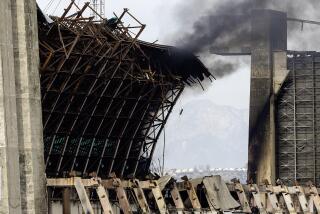TUSTIN : City’s Past Comes Alive at Museum
- Share via
When Evelyn Ojeda posed with her Tustin Union High School basketball team 58 years ago, she never dreamed that one day the photograph would hang in a museum.
The 1931 photograph is on display at the Tustin Area Historical Museum, where Ojeda works as a volunteer. The school, incidentally, was demolished more than 20 years ago.
The museum features not only early photos, but also artifacts and other items that allow visitors to glimpse early life in Tustin.
On display are tools and furniture from the city’s early agricultural days, fossils, a Spanish saddle and branding iron from the county’s rancho period, and Indian artifacts.
A 100-year-old time clock used at a local fruit company still rings when punched. A peanut-roasting machine that once stood in a pool hall is now used as a donation box for the museum, where admission is free but gifts are accepted.
Some days are busier than others. During the city’s annual chili cook-off last year, 350 visitors toured the 1,627-square-foot museum, Ojeda said. Other days only a few people show up.
Tim Fruehe and Robert Guevara wandered through the museum recently after driving by it many times on their lunch break from a Santa Ana company.
“We love looking at the old houses in the area and were curious to see the old photos and stuff,” said Fruehe, an artist from Fullerton.
“It’s pretty interesting,” Guevara said. “They should really advertise it so people know about it.”
The museum was founded in 1976 as an outgrowth of the U.S. Bicentennial celebration, said Carol Jordan, one of the founders. Originally housed in the city’s old police building, it moved in 1979 to its present home in the Knights of Pythias building, at El Camino Real and Main Street.
One of the museum’s featured items is the city’s first fire truck, a converted 1912 Buick with wooden-spoked wheels and a hand-cranked siren. Sam Tustin, the son of city founder Columbus Tustin, donated the Buick to the Chamber of Commerce. It was used by the city’s volunteers to battle blazes from about 1922 to 1936, and later was used in parades.
Even older firefighting equipment is on display. A chemical tank on wooden wheels was pushed to fires by firemen or towed by a car. When the tank was inverted, chemicals spilled into the water and a reaction created the pressure needed to force the water through a hose.
Pictures show the city’s early residents and their homes. When incorporated in 1927, the town had 900 residents.
A photo of Tustin in the 1950s depicts a square mile of houses and shops surrounded by orange groves.
The museum, which is supported by book sales, rental assistance from the city and dues from Tustin Area Historical Society members as well as donations, is open from 9 a.m. to 2 p.m. Tuesdays and Thursdays and 10 a.m. to 3 p.m. the first Saturday of each month. Group tours are given by appointment.
More to Read
Sign up for Essential California
The most important California stories and recommendations in your inbox every morning.
You may occasionally receive promotional content from the Los Angeles Times.













